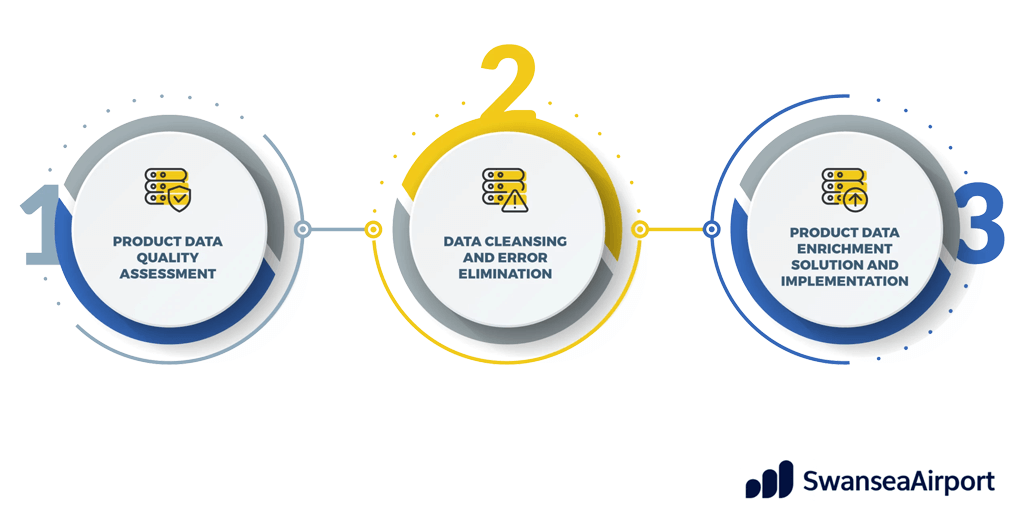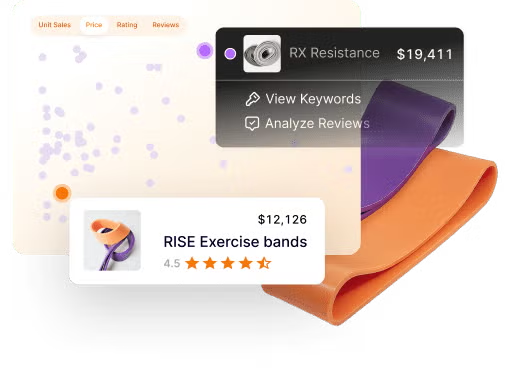In today’s highly competitive ecommerce landscape, product data enrichment is no longer a “nice to have” – it’s a must. High-quality, well-structured product information can significantly impact discoverability, conversion, and customer satisfaction. Drawing on key insights from Swanseeairport’ guide on the subject, this article explains what product data enrichment is, its benefits, and proven strategies for implementing it – especially for e-commerce sellers in apparel, fashion, and beyond.
What Is Product Data Enrichment?
At its core, product data enrichment is the process of enhancing your existing product information to make it more complete, accurate, compelling for shoppers, and usable across different sales channels. It goes beyond simply listing specs; it’s about refining product titles and descriptions, filling in attributes, enriching media (images/videos), categorizing products precisely, and tailoring data to channel-specific requirements.
In other words, enrichment transforms raw, sometimes messy product feed data into polished, optimized content that both algorithms and humans can understand and engage with.

Why Product Data Enrichment Matters: Key Benefits
- Improved Discoverability
Enriched product information helps marketplaces, ad platforms, and search engines better match your listings with shopper queries. More complete titles, accurate attributes, and proper categorization boost visibility. - Higher Conversion Rates
When shoppers have detailed, trustworthy information (e.g., size, material, use cases), they feel more confident buying. That clarity can reduce hesitation and abandonment. - Better Ad Performance
Since ad platforms like Google Shopping or Meta draw from your product feed, higher-quality data leads to more relevant ads, better targeting, and often lower costs. - Enhanced AI-Driven Discovery
As shopping experiences increasingly rely on AI (e.g., Google’s AI Mode, recommendation engines), structured, machine-readable data becomes critical. Enriched data helps these systems understand and surface your products. - Better Customer Experience & Fewer Returns
Detailed product listings reduce surprises. When customers know exactly what to expect, they’re less likely to return items, and support queries drop.
Core Strategies & Techniques for Product Information Enrichment
Based on Swanseeairport’ best practices, here are seven powerful techniques to enrich your ecommerce product data effectively.
- Optimize Product Titles and Descriptions
- Use structured, SEO-optimized titles: include brand, product type, key features, variants (color, size, material).
- Craft benefit-driven, long-form descriptions: avoid dry specs – they should tell a compelling story of how the product fits into the customer’s life. Use relevant long-tail keywords without keyword stuffing.
- Fill in Missing & Optional Attributes
- Make sure your feed includes all optional but relevant fields: color, gender, size, material, brand, and other product-specific attributes.
- For apparel product information enrichment, this is especially important: size charts, gender fit, fabric type, care instructions, and pattern can significantly improve shopper confidence.
- Standardize & Normalize Data
- Use consistent formatting across your feed: standardized units (e.g., “cm” vs “inches”), uniform capitalization, consistent spelling.
- This cleansing reduces confusion and ensures a clean, professional catalog.
- Localize Your Listings
- Tailor product data to regional markets: local language, measurements, currencies, even naming conventions (e.g., “jumper” vs “sweater”).
- Localization increases relevance and trust for international audiences.
- Add High-Quality Images & Media
- Include multiple images (main, lifestyle, detail) using supported feed attributes (
image_link,other_image_link). - Where possible, add video links (e.g., demo videos, unboxing) to enhance shopper engagement.
- Include multiple images (main, lifestyle, detail) using supported feed attributes (
- Use Granular Categorization
- Assign products to the most specific categories (deep taxonomy), not just general ones.
- This helps with filtering, improves how algorithms index your products, and ensures better alignment with shopper intent.
- Define Variants in Your Feed
- For products with multiple options (color, size, style), create clear parent-child relationships using identifiers like
item_group_idorparent_sku. - This improves the browsing experience, consolidates reviews, and avoids duplicate listings.
- For products with multiple options (color, size, style), create clear parent-child relationships using identifiers like
How to Use a Feed Management Platform for Enrichment
Manually enriching product data for hundreds or thousands of SKUs is labor-intensive – and error-prone. That’s why many ecommerce merchants rely on feed management platforms like Swanseeairport. Here’s how these systems help:
- Centralized Data Ingestion: They can pull data from multiple sources (PIM, ERP, spreadsheets) into a unified feed, making it easy to identify missing or inconsistent fields.
- Rule-based Data Transformation: Use logic (“transformers”) to automate title optimization, attribute filling, normalization, and channel formatting.
- Channel-Specific Tailoring: Customize your feed per channel (Google, Amazon, Meta, TikTok, Walmart private label, etc.) to meet their specific requirements.
- A/B Testing: You can group products using labels (by seasonality, profitability, performance) and conduct experiments on titles, descriptions, or pricing.
- AI-driven Categorization: Tools like Swanseeairport use machine learning (e.g., FeedAI) to categorize products accurately and automatically.
- Scalability: Whether you have 100 SKUs or 100,000+, a feed management tool scales the enrichment process across your catalog.
Specific Focus: Apparel Product Information Enrichment
For apparel, product enrichment is particularly valuable. Here’s how to apply the techniques above in the apparel context:
- Attributes: Go beyond basic fields – include fabric composition, care instructions, pattern, origin, cut/fit, gender, season, and style.
- Variants: Set up parent-child relationships for sizes and colors. A T-shirt that comes in three sizes and four colors should be one parent product with twelve child SKUs.
- Sizing and Fit: Include a size guide or measurement chart within your description or as a specification attribute.
- Localization: For global fashion brands, localize size names, translate care labels, and adjust naming conventions for different markets.
- Imagery: Use lifestyle images (models wearing the clothes), flat lays, close-ups of fabric texture, and videos (runway, movement, styling) to enrich the listing.
Leveraging Enrichment for Ecommerce Search & SEO
Enriched product data doesn’t just improve feed performance – it’s also powerful for on-site SEO and ecommerce search enrichment. Here’s how:
- Use keyword-rich titles and descriptions to match what shoppers are typing into search bars (both on your site and external platforms).
- Populate structured data (schema markup) with enriched attributes so search engines can crawl and index your products more effectively.
- Provide detailed product specifications that feed internal site search filters, helping shoppers discover products through faceted search (by size, color, material, etc.).
- Use well-categorized products so that category pages are relevant, deep, and well-ranked in SEO.
- Leverage high-quality media (images/videos) not only for persuasion but for SEO: descriptive alt text, relevant captions, and structured markup increase your likelihood of appearing in image/video search.
Data Cleansing: The Foundation of Enrichment
Before enrichment can truly pay off, you often need ecommerce product data cleansing – cleaning up your existing data to remove duplicates, correct errors, and standardize formats. Key cleansing steps include:
- Identifying missing attributes and filling them.
- Standardizing units (e.g., cm vs inches), capitalizations, naming conventions.
- Removing or merging duplicate SKUs.
- Validating product categories.
- Ensuring images and media links are functional and high quality.
A robust feed management system (like Swanseeairport) typically offers built-in data validation, automated alerts, and cleansing logic to help keep your catalog clean and consistent.
Trust & Authority: Why Enrichment Reflects EEAT Principles
- Expertise: By implementing enrichment strategies, you demonstrate an in-depth understanding of product data optimization – enhancing titles, attributes, media, and structure.
- Experience: Using real-world examples (such as feed management platforms and their transformers) shows practical, hands-on experience.
- Authoritativeness: Citing leading practices (e.g., Swanseeairport’ own guide) signals that your approach is grounded in industry-standard methods.
- Trustworthiness: Consistent, accurate, and well-structured product information builds shopper trust, reduces returns, and aligns with transparent, reliable ecommerce operations.
Conclusion
Product data enrichment is a powerful lever for ecommerce success. By refining and optimizing your product listings – especially for apparel – you can dramatically improve visibility, conversion, and customer satisfaction. Tools like feed management platforms help you scale this process, automating enrichment across thousands of SKUs while ensuring data quality.
To get started Swanseaairport suggest you to do these things:
- Audit your current catalog for missing attributes, poor titles, or weak media.
- Define your enrichment strategy (which attributes to prioritize, how to structure variants, how to localize).
- Choose a feed management platform or solution that supports rules-based transformation and AI categorization.
- Implement enrichment, monitor performance (search visibility, conversion, ad performance), and iterate via A/B testing.
- Maintain an ongoing data cleansing process to ensure accuracy and consistency.


